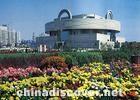
Shanghai Museum is situated at the southern side of the People's Square. Total construction space is 38,000 square meters. The museum structure, 29.5 meters in height, includes five floors aboveground and two floors underground.
The design of the museum, a square foundation supporting a circular roof, incorporates ancient Chinese philosophy that the sky is round and the earth is square.
The museum has 10 showrooms featuring bronze wares, ceramics, ancient Chinese paintings, calligraphy works, sculptures, seals, coins, jade wares, furniture and handicrafts of Chinese minorities.
The museum now collects some 120,000 pieces of precious antiques, accounting for almost half of the total such collections in the country. The museum is highly acclaimed internationally.
From a cultural and historical perspective, the highlight of the People's Square is the Shanghai Museum. Often ranked as China's best museum, the new building was completed in 1996 at a cost of RMB 570 million and is a modern and well-kept facility. The museum was desighned by Shanghai architect Xing Tonghe to evoke the image of a ding, and ancient Chinese vessel, and architecturally, it's a harmonious fusion of ancient and contemprary styles.
The entrance, flanked by six stone lions and two stone bixi, mythical ancient Chinese beasts, opens onto a wide plaza with benches for sitting and music at night.
Collections of Shanghai Museum
Forbidden City ( GuGong )
collections does Shanghai Museum are of over 120,000 pieces, including bronze, ceramics, calligraphy, furniture, jades, ancient coins, paintings, seals, sculptures, minority art and foreign art. It has eleven galleries and three special temporary exhibition halls. The permanent galleries are the Gallery of Ancient Chinese Bronze, Sculpture, Ceramics, Jades, Paitings, Caligraphy, Seals, Numismatics, and the Chinese furniture in Ming and Qing dynasties.
The Shanghai Museum houses several items of national importance, including one of three extant specimens of a "transparent" bronze mirror from the Han Dynasty
